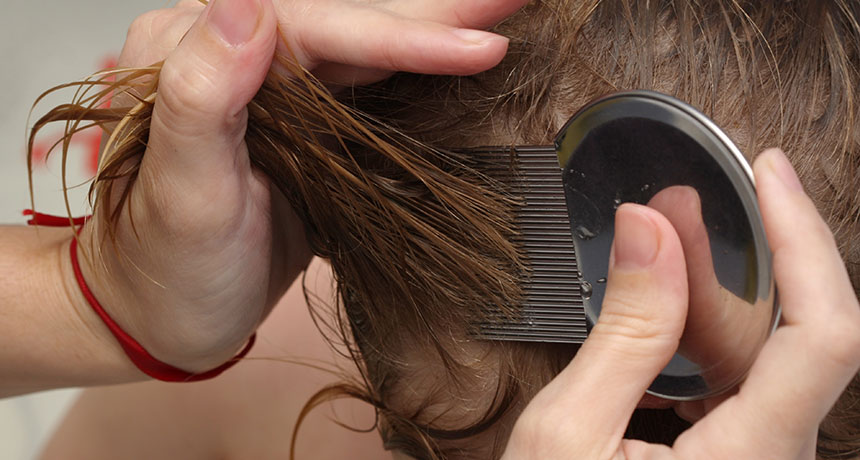When fighting lice, focus on kids’ heads, not hats or toys

Compared with spot-checking the scalp, pulling a fine-toothed metal comb through hair that’s slick with conditioner turns up more lice and eggs.
KevinDyer/iStock/Getty images plus
- More than 2 years ago
I recently attempted a technically demanding “around the world” braid on my kindergartner. On my sloppy and meandering approach to the South Pole, I discovered a loathsome sight that scuttled my circumnavigation — a smattering of small, brownish casings stuck onto hairs.
I tried to convince myself that I was looking at sand. She’s always covered in sand! But I’ve spent enough time around insects to know that I was looking at something biological. Bad braid abandoned, I began combing through, looking for more specks. And I sure found them: Lice eggs, or nits, that were glued onto the hair next to the scalp, and precisely one live bug.
Today, I am delighted to report that our outbreak is over. (Although with three young children, our situation will probably swing between “having lice” and “waiting to have lice again.”) Our first brush with the little buggers sent me into full research mode, and I’m now armed with a deeper understanding of lice habits and preferences. In the interest of streamlining your next lice experience, I offer below some little-known and helpful facets of lice life.
The best way to spot lice and their tiny nits is with wet combing.
Compared with spot-checking the scalp, pulling a fine-toothed metal comb through hair that’s slick with conditioner turns out more critters.
Pepper-sized nits can range from white to brown in color and are glued to single hairs. These suckers are on tight: You might need a fingernail to pop them off. Live nits need to be close to the warm scalp to survive; casings that are farther than a centimeter away from the scalp are probably empty or contain dead eggs.
Once hatched, a live human head louse, or Pediculus humanus capitis, grows no larger than the diameter of a pencil eraser. It’s grayish white. And its favorite — and only — food is blood from a human scalp, which it slurps several times a day.
Super lice laugh at pesticides.
More and more lice can withstand permethrin or pyrethrins, the pesticides inside most of the boxes you’ll find in your panicked drugstore run. And there’s not much evidence for other treatments, including mayonnaise and tea tree or lavender oil. And please don’t even think about gasoline.
An emerging favorite treatment is a silicone-based gel thought to smother lice and their eggs. Called dimethicone (also spelled dimeticone), it outperformed permethrin in one head-to-head test conducted by a team of researchers (that included scientists who had consulted for a lice treatment company). Because it works by physically coating the bugs, the treatment is unlikely to lead to more resistance.
Lice burrowed onto heads are surprisingly hardy, even underwater.
In one series of experiments, researchers watched lice cling to cut hair in regular water, seawater, salt solutions and even chlorinated water. The pests didn’t respond to a poke, either, researchers found.
Another study looked at lice pulled off the heads of people in France. After six hours underwater, all the lice in the experiment (188 of them) were happily alive. About half of the lice were still alive after 24 hours underwater. Hardy, I say.
But: Lice are wusses when not on a head.
Off their favorite spot, adult lice quickly dry out and starve, particularly in dry environments. Most are dead within 40 hours after their last meal. And it is unlikely that eggs removed from a head can yield healthy adults.
Lice aren’t all that contagious.
They can’t jump, fly or swim. Their dire need for a human head means that direct head-to-head contact, such as the type you see with little girls coloring together, is what allows lice to crawl to a new home.
“The control of head lice should focus on the head, not on the environment,” researchers wrote in 2010 in The Open Dermatology Journal. That paper mentions a study of over 1,000 hats, worn by students who, combined, had over 5,500 lice on their heads. The heads had lice, but the hats didn’t. The risks of transmission from hairbrushes, hats, helmets and toys are really, really low. The same goes for flooring: When researchers combed the floors of 118 classrooms at a school with a known lice outbreak, they turned up no lice.
All this to say that you don’t need to wage war on your house and bag up your kid’s clothes, bedding and stuffed animals for three days. “This recommendation has no basis in science,” a 2016 review stated.
Lice aren’t dangerous.
They are gross, to be sure, but they’re not a menace to public health. Kids don’t usually get sick from lice, beyond a little bit itchy. That’s why the American Academy of Pediatrics objects to “no nit” school policies that prevent kids with lice from attending. The Centers for Disease Control and Prevention agrees, as does the National Association of School Nurses.
Lice can be a valuable commodity, in exactly one scenario:
Shrek (the real ogre in the delicious book, not the sanitized movie version) trades several of his rare lice to a witch in exchange for his fortune. It’s a great deal.
So there you have it. I’d certainly prefer to live a lice-free life, but now that I know more about these relatively harmless insects, I feel a little bit better about our prospects.







